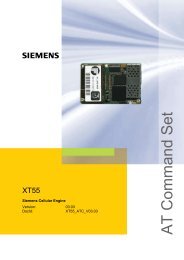Hardware Interface Description - Wireless Data Modules
Hardware Interface Description - Wireless Data Modules
Hardware Interface Description - Wireless Data Modules
Create successful ePaper yourself
Turn your PDF publications into a flip-book with our unique Google optimized e-Paper software.
MC55/56 <strong>Hardware</strong> <strong>Interface</strong> <strong>Description</strong><br />
Confidential / Released<br />
s<br />
3.12.2 Outputs<br />
3.12.2.1 Synchronization signal<br />
The synchronization signal serves to indicate growing power consumption during the transmit<br />
burst. The signal is generated by the SYNC pin. Please note that this pin can adopt two<br />
different operating modes which you can select by using the AT^SSYNC command (mode 0<br />
and 1). For details refer to the following chapter and to [1].<br />
To generate the synchronization signal the pin needs to be configured to mode 0 (= default).<br />
This setting is recommended if you want your application to use the synchronization signal<br />
for better power supply control. Your platform design must be such that the incoming signal<br />
accommodates sufficient power supply to the MC55/56 module if required. This can be<br />
achieved by lowering the current drawn from other components installed in your application.<br />
The timing of the synchronization signal is shown below. High level of the SYNC pin<br />
indicates increased power consumption during transmission.<br />
1 Tx 577 µs every 4.616 ms<br />
2 Tx 1154 µs every 4.616 ms<br />
Transmit burst<br />
SYNC signal *)<br />
300 µs<br />
Figure 22: SYNC signal during transmit burst<br />
*)<br />
The duration of the SYNC signal is always equal, no matter whether the traffic or the<br />
access burst are active.<br />
MC55/56_hd_v02.06 Page 62 of 105 29.10.2004














